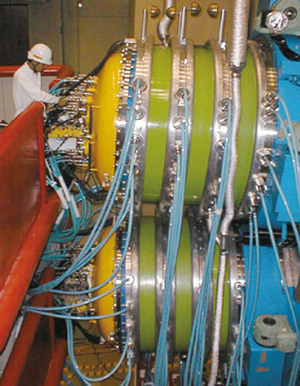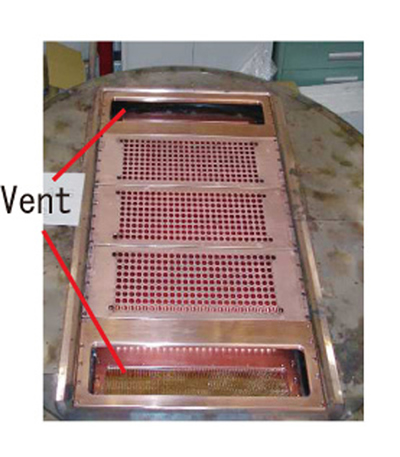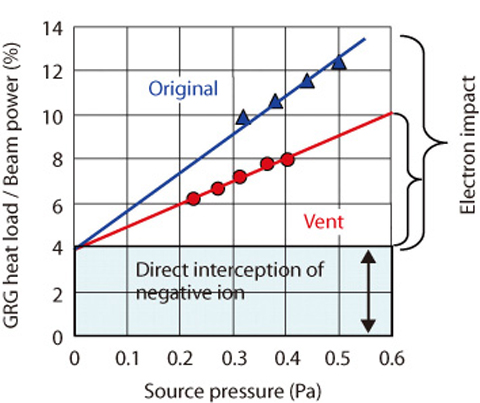
Photo3-1 Negative ion source for JT-60U

Photo3-2 Vent of acceleration grid

Fig.3-17 Dependence of the grounded grid(GRG) heat load on source pressure
A negative ion based neutral beam injector (NNBI) was desired to extend pulse duration from the design value of 10 s up to 30 s, maintain the plasma characteristic of "JT-60U" for a long period. Photo3-1 shows the negative ion source for "JT-60U". The pulse duration has been restricted by the temperature rise of cooling water. To extend pulse duration, it was necessary to reduce the heat load on the acceleration grids. There are two causes of the grid heat load. One is the direct interception of accelerated negative ions and the other is electrons co-accelerated with negative ions. In this research the reduction of heat load by electrons was attempted. Many electrons are generated by being stripped from negative ions when the negative ions collide with residual gas molecules in the accelerator. The electrons produced there are accelerated and collide with the acceleration grids. These stripped electrons can be reduced by decreasing pressure in the ion source. However, the pressure in the source chamber needs to be around 0.3 Pa so as to extract large negative ion current. In order to reduce pressure in the accelerator while keeping the pressure in the source chamber at 0.3 Pa, the structure of the acceleration grid segment is modified as seen in Photo3-2. Acceleration grids are composed of five segments, and in the original design, negative ions are extracted from all five segments. To lower pressure in the accelerator, vent grids were added to both sides of acceleration grid segments. In this case, the upstream plasma grids are masked so that negative ion beam are not extracted as they pass through vent grids. Fig.3-17 shows the dependence of the grounded grid (GRG) heat load ratio per beam power on the source pressure. In this figure, the GRG heat load ratio increases with the source pressure. This increase seems to be caused by electron impact, whereas the heat load ratio which is present regardless of pressure, around 4%, is negative ion interception. By decreasing pressure at the accelerator with the vent grids, the production of stripped electron is restrained, and the heat load ratio due to electron impact is reduced about 40%. This leads to restraint of the temperature rise of cooling water by about 35 degree under steady state condition more than 10 s. The pulse duration of one ion source was extended up to 25 s.